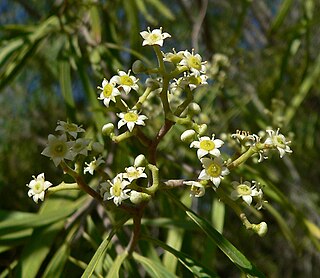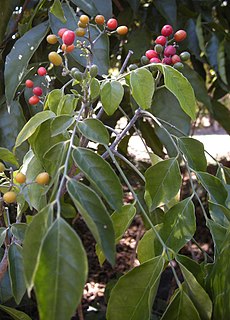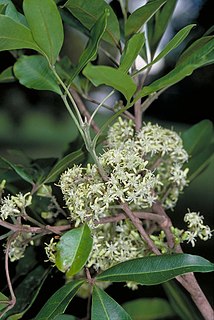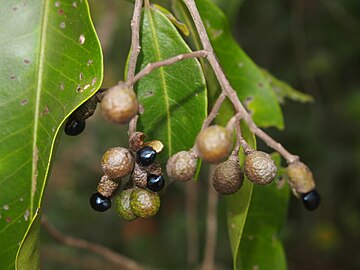
Geijera is a genus of shrubs and trees in the family Rutaceae and are native to New Guinea, Australia and New Caledonia. They have simple leaves arranged alternately, panicles of bisexual flowers usually with five, sometimes four, sepals, petals and stamens and fruit containing shiny black seeds.

Murraya paniculata, commonly known as orange jasmine, orange jessamine, china box or mock orange, is a species of shrub or small tree in the family Rutaceae and is native to South Asia, Southeast Asia and Australia. It has smooth bark, pinnate leaves with up to seven egg-shaped to elliptical leaflets, fragrant white or cream-coloured flowers and oval, orange-red berries containing hairy seeds.

Zanthoxylum brachyacanthum, known as thorny yellow-wood, satinwood, satin tree or scrub mulga, is a species of flowering plant in the family Rutaceae and is endemic to north-eastern Australia. It is a rainforest shrub or tree with thick, cone-shaped spines on the trunk and prickles on the branches, pinnate leaves, and male and female flowers arranged in panicles.

Acronychia baeuerlenii, commonly known as Byron Bay acronychia, is a species of rainforest shrub or small tree endemic to eastern Australia. It has simple, glabrous leaves, small groups of flowers and fleshy oval fruit.

Sarcomelicope simplicifolia, commonly known as bauerella, hard aspen or yellow-wood, is a species of flowering plant in the family Rutaceae and is endemic to eastern Australia including Lord Howe and Norfolk Islands. It is a shrub or small tree with elliptic to egg-shaped leaves arranged in opposite pairs, male or female flowers arranged in small groups in leaf axils and fruit an oval to spherical drupe.

Acronychia laevis, commonly known as hard aspen, glossy acronychia or northern white lilly pilly, is a species of shrub or small tree in the citrus family, and is endemic to eastern Australia. It has simple, elliptical to egg-shaped leaves, groups of creamy white flowers and fleshy, mitre-shaped to spherical fruit.

Acronychia wilcoxiana, commonly known as silver aspen, doughwood, snowwood or mushyberry, is a species of small rainforest tree that is endemic to eastern Australia. It has simple, elliptical to egg-shaped leaves with the narrower end towards the base, relatively large groups of whitish flowers in leaf axils and broadly oval to more or less spherical, white fruit.

Acronychia pubescens, commonly known as hairy acronychia or hairy aspen, is a species of tall shrub or small tree that is endemic to eastern Australia. It usually has trifoliate leaves, rarely simple leaves, groups of whitish flowers in leaf axils and creamy to yellowish, elliptical to spherical fruit.

Geijera parviflora, commonly known as wilga, is a species of shrub or small tree in the family Rutaceae and is endemic to inland parts of eastern Australia. It has drooping branches, linear to narrow lance-shaped leaves, small white flowers in loose panicles and spherical fruit containing a shiny black seed. Other vernacular names include Australian willow, native willow, sheepbush and dogwood.

Micromelum minutum, commonly known as limeberry, dilminyin. kimiar margibur, tulibas tilos (Philippines), sesi (Indonesia) and samui (Thailand), is a species of small tree or shrub in the citrus plant family Rutaceae. It occurs from India and Indochina to Australia. It has pinnate leaves with egg-shaped to lance-shaped leaflets, hairy, pale green or creamish, scented flowers arranged in large groups and yellow to orange or red, oval to spherical berries in dense clusters.

Halfordia is a genus of plants in the family Rutaceae containing the single species Halfordia kendack commonly known as kerosenewood, southern ghittoe or saffronheart, is a rainforest plant that is native to eastern Australia, New Guinea and New Caledonia. It is a shrub or tree with elliptical to egg-shaped leaves with the narrower end towards the base, panicles of white, greenish white or yellowish flowers and purple to bluish black, spherical to oval fruit.

Boronia lanceolata is a plant in the citrus family Rutaceae and is endemic to northern parts of the Northern Territory and Queensland. It is an erect shrub with many branches, elliptic to lance-shaped leaves and white or pink, four-petalled flowers. It is the most common boronia in the Northern Territory.

Acronychia acronychioides, commonly known as white aspen, is a species of small to medium-sized rainforest tree that is endemic to north-eastern Queensland. It has trifoliate leaves with elliptic to egg-shaped leaves on stems that are more or less cylindrical, creamy yellow flowers in large groups in leaf axils and fleshy, pear-shaped or spherical fruit.

Acronychia acuminata, commonly known as Thornton aspen, is a species of shrub or small rainforest tree that is endemic to north-eastern Queensland. It has simple leaves on stems that are more or cylindrical, flowers in small groups in leaf axils and fleshy, oval to spherical fruit.

Acronychia crassipetala, commonly known as crater aspen, is a species of small rainforest tree that is endemic to north-eastern Queensland. It has simple, elliptic to egg-shaped leaves on cylindrical stems, flowers in small groups, and fleshy, more or less spherical fruit.

Acronychia imperforata, commonly known as Logan apple, Fraser Island apple, or green tree, is a species of rainforest shrub or small tree that is endemic to north-eastern Australia. It has simple, elliptical to egg-shaped leaves, small groups of yellowish or creamy white flowers and fleshy spherical to oval fruit.

Acronychia parviflora is a species of shrub or small rainforest tree that is endemic to north-eastern Queensland. It has simple, egg-shaped to elliptical leaves, flowers arranged singly or in small groups in leaf axils and fleshy, more or less spherical fruit.

Acronychia vestita, commonly known as white aspen, lemon aspen, hairy aspen or fuzzy lemon aspen, is a species of rainforest tree that is endemic to Queensland. It has simple, elliptic to egg-shaped leaves with the narrower end towards the base, flowers arranged in relatively large groups, mostly in leaf axils and fleshy, pear-shaped to more or less spherical fruit.
Coatesia is a genus of plant containing the single species Coatesia paniculata, commonly known as axe-breaker or capivi, and is endemic to eastern Australia. It is a small, evergreen tree with simple, elliptical to egg-shaped leaves, panicles of white flowers on the ends of branchlets or in leaf axils and fused follicles with one black seed in each follicle.

Melicope broadbentiana, commonly known as false euodia, is a species of shrub or tree in the family Rutaceae and is endemic to Queensland. It has simple leaves, trifoliate leaves or both, and small white flowers borne in short panicles in leaf axils.























